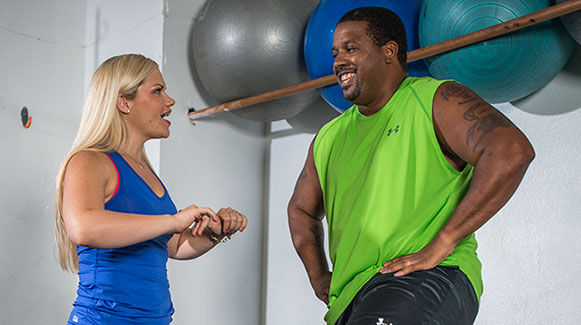
“You guys are having too much fun!”
“You make such a great connection with your clients. I think it’s why you’re so successful with them and why they become long-term clients.”
These comments are from members of the gym where I train clients. They are a testament to my training style, which tends to be professional, yet personal—and often results in becoming friends with my clients.
JOIN THE DISCUSSION!
How do you identify and set appropriate boundaries with your clients? Are there topics that you believe are simply off the table? How do you handle it when a client views you more as his or her friend than as the trainer? Let’s us know your thoughts and opinions on this important topic in the comments section below.
Considering the amount of time you spend with your clients, it’s entirely natural for you to become more than just their "coach," says Jamie Walker, CEO and founder of SweatGuru out of San Francisco, Calif. “If they initiate a more personal relationship and you feel comfortable with them, I think it’s fine to be friends with your clients outside of work. In fact, I believe it is your job to connect with your clients. I believe knowing tidbits about your clients’ lives can help influence the kinds of training, programs and tips you offer them. Every client is different and understanding that is the key to being a great trainer.”
Walker feels sharing your life with your clients also helps establish trust within the trainer-client relationship. “Working out can be very personal and often even emotional for people, so I think establishing trust and connection is a key to success.”
Trish DaCosta, founder of Love Life Fit in San Diego, Calif., agrees. “It’s important to share something about yourself, to give the client something to connect to. By treating the client as a customer first and personal relationship second, trainers maintain the focus on the training session without compromising a great working relationship.”
However, she does set boundaries. “While I encourage my clients to share what is happening in their personal lives so I can get insight into what may be impacting their progress in the gym, I avoid sharing my opinion on personal matters, no matter how much they insist! I remind myself that I am their sounding board; my opinion regarding a personal matter crosses the line between personal and professional.”
“Boundaries are key in any relationship,” adds Sue Hitzmann, M.S., creator and author of The MELT Method. “I think you have to be mindful of what you share with people in general.”
Hitzmann also feels that having some knowledge of psychology is important for trainers. “I would honestly say psychology is a key element in service industries. You have to know how to empathize with people, meet them where they’re at, listen and ask questions. I think giving information about how you live your life should be to give perspective, not depth of relationship.”
Determining Appropriate Boundaries for You and Your Clients
Joel Harper, a celebrity personal trainer in NYC, says he trusts his gut as far as how friendly to become with his clients, but feels that overall it’s best to keep it friendly and professional. “Some clients I can tell have boundary issues, so I am very strict with them. Others I can tell are trustworthy and I would be friends with them, so I am a little less rigid.”
Harper believes that if you feel a client is trustworthy, it can help motivate the client if you share some of your life with them. “It creates a connection and you are not just a robot. People want to feel heard and connected. It is key to do both and be aware of their boundaries.”
For some trainers, however, their own boundaries are set much tighter. “When it comes to working with my clients,” says Jen Jewell, celebrity trainer in Calif., “I try to keep it as professional as possible. If I’m having a bad day or my mood is somehow affected or I’m going through a hard time of sorts, they will never know about it. Aside from the basics and some small talk and generic conversation, I don’t believe in sharing personal information with your clients.”

Jewell’s professional sense comes from working as an outside sales rep after college. “I worked in the corporate world for several years and had clients of all kinds over the years,” she explains. “I would not have discussed their relationship issues or shared details about my weekend trip with the girls with those clients—nor would I have expected or wanted them to share those details of their lives with me. I think more trainers need to keep this in mind when it comes to working with their clients.”
Holly Chisholm Hargrave, M.A., owner and founder of AthleticGenius Fitness, feels allowing clients to share their lives is an important part of training. “Having the ability to share their personal challenges with someone they trust is an important part of the mental aspect of the training session,” she says. “It’s also critical that as a trusted confidant, I never repeat any personal information a client shares with me. My clients and I have a saying, ‘What happens in the gym, stays in the gym.’”
However, when it comes to discussing her own life with her clients, the rules change. “As a trainer I never share my personal information with my clients,” says Hargrave. “As a trainer it does not matter how your day is going. It is your job to offer inspiration, motivation and teach proper training technique.”
You Are Personally Invited…
It’s one thing to be friends with clients inside the gym, but what about invitations to parties, dinner and other events outside the gym?
“Trainers should feel welcome to accept invitations from clients, [as long as] the trainer is comfortable and there’s a solid working relationship that’s been established,” explains DaCosta. “Sharing a drink or engaging in social behavior with a client can help build that relationship and establish a foundation of trust between the two. It also invites the trainer into the client’s lifestyle and habits, which provides greater insight for the work done in the gym together.”
However, she doesn’t feel accepting invitations from new clients is acceptable. “Accepting invitations from a brand new client, however, could do more harm than good to the trainer-client dynamic and I advise against it in the beginning.”
Hitzmann, however, has a different perspective on socializing with clients and feels it can create a very tenuous situation, essentially taking advantage of the client-trainer relationship. “They then feel they’re your friend and when they cancel they think they don’t have to pay, think they can show up late, etc.”
“Socializing with clients is a big ‘no’ in my book, because it changes the dynamic of the relationship,” explains Hargrave. “Especially important is to not go drinking or partying with clients. A trainer should model fitness and well-being. Maintain your clients’ respect by respecting them and providing an unbiased example of trustworthiness, dedication and fitness expertise.”
“I think it’s very important to support my clients outside of their training sessions,” challenges Harper. “Once a week I go to a client’s play, exhibit or runway show. They are supporting me and I think, energetically, it is very important to show up for them.”
DaCosta turns social activities into professional marketing opportunities. “As a trainer, I’ve built great friendships with clients and turned them into brand ambassadors by engaging in social activities with them. This has never negatively impacted the work we do together when it’s time to exercise. Trainers can have a greater impact on their clients by allowing them to see our personalities outside the gym and vice versa.”
So in the End…to Friend or Not to Friend?
As a trainer, you necessarily have to figure out your own personal boundaries and style of working with clients, if you haven’t already. How friendly you become with your clients will depend on many variables, including your own personal philosophy, your clients’ personalities, and even the size of your community. If, for instance, you come from small community like mine, there’s a good chance you already know the people who hire you to train them. And remember, there’s a reason they call it personal training. Clients who prefer an all-business approach to training will choose a trainer who takes that same approach. And those who prefer a more relaxed style will choose a trainer who fits their personality. I think Walker sums it up best:
“Of course, every client relationship is different and you should always use your best judgment when approaching situations that blur the line between professional and personal,” he says. “Use your best judgment, but know that it’s okay to be relatable!”





 by
by 



